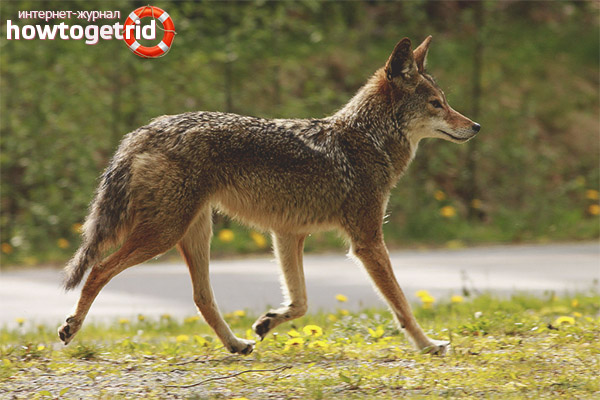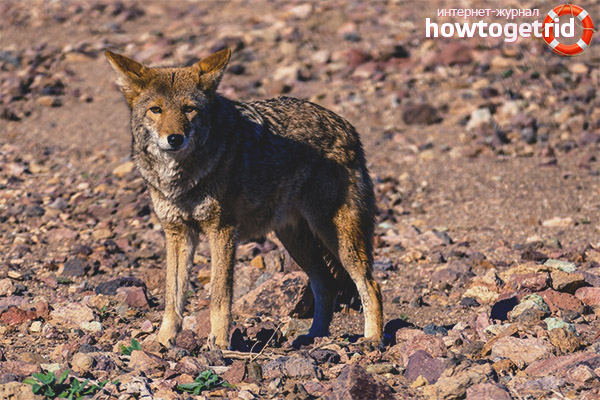The content of the article
By coyote is meant an animal living preferably in the open spaces of North America. Individuals quickly adapt to the environment in which they live, therefore they find a food base and breed successfully. Representatives of the canine family are classified as mammals and the type of chordates. Coyotes can be considered relatives of foxes, dogs, wolves. To date, more than 18 varieties of coyotes are distinguished, each species differs in its habits and way of being.
Description
- Most individuals are dispersed throughout Canada, North America, the United States of America and Mexico. Mammals are also found in Eurasia, but in their places they are much smaller. You will find more detailed information regarding distribution below, but for now, we give the external characteristics of the individuals represented.
- In terms of overall characteristics, these animals are slightly smaller than wolves. The hull extends to a maximum of 1 meter in length, an additional about 25 cm is given to the tail. At the withers, the mammal grows to half a meter, however, representatives of the family are often found much less. As for the mass, it directly depends on the fatness and food supply of a particular individual. It can be about 8-20 kg.
- A distinctive feature of the animals discussed is the ears of a standing format, this feature of the individual is somewhat reminiscent of wild dogs. The tail is medium-sized, but at the same time fluffy and even. Individuals living in the mountains are pigmented a little darker than their counterparts, living preferably in desert areas. The first is dark, brown, the second is painted in brown or beige.
- The fur is dense and elongated. Reddish blotches are often found on it, but most of the population is pigmented in black and gray. The abdominal section is brightened, closer to beige or whitish. The outskirts of the tail have a black speck. If we compare the data of mammals with wolves, the first muzzle is sharpened more strongly.
Lifestyle
- Despite the fact that these animals are not gullible, they can often be found near a human home. Representatives of the family under discussion occupy territorial plots on the outskirts of cities and towns, after which they inhabit. Wolves, in turn, try to stay away from humans.
- Coyote likes moderately overgrown areas dominated by desert zones. They bypass the woodland. Great activity is manifested in twilight or night hours, in the daytime individuals prefer to hide and sleep off for further hunting after sunset.
- Individuals who have reached puberty are ready for independent existence. They are excellent builders, dig minks and settle in abandoned places. An adult mammal occupies its own individual site, which is carefully guarded. The area is about 20 km., Sometimes more. Individuals label urine, thus showing others whose territory it is. In the future, they are guided by the notes when they depart far from home in search of a food supply.
- Animals breed fast enough when there are no wolves nearby. These mammals are classified as small-sized. But this does not stop them from making long jumps up to 4 meters in length. During the hunt, animals accelerate to 60 kilometers per hour and even more.
- These individuals can adapt to the most severe climatic conditions and changes in their natural habitat. Most of the population is dispersed throughout North America. Some representatives also populated the central, southern parts of the continent.As for the duration of existence, animals are up to ten years, but often die prematurely. In captivity, coyotes live from 15 years and more due to the quality of food and care.
Nutrition
- Representatives of the family are omnivorous. They are not too picky in terms of food choices. Most of the basic diet is animal food. Especially often gophers, rabbits, rodents of small type are hunted. Also eat raccoons, possums, beavers, various species of birds, insects.
- Mammals feel great in the aquatic environment. They hunt fish and frogs, absorb newts and other animals of this kind. When it is possible to enjoy the fruits, the menu is brightened up with plant-based foods. We are talking about berries and fruits, some especially enterprising individuals eat nuts and seeds.
- The menu is varied, depending on the season. When there is little food, then animals absorb carrion, hunt wounded animals in order to save their energy. Some specifically seek out sick animals, after which they are killed and consumed as food. If coyotes live in national parks, they get used to visitors and enjoy themselves.
- Studies were conducted during which it was possible to establish what and in what volume these mammals eat. A quarter of their daily menu is carrion, a little less allocated to rodents and livestock.
- Rarely, individuals hunt wild deer, eat birds and insects. Plant food is rare, less than two percent is given to it. As for livestock, coyotes attack him only when there is nothing to eat at all. At the same time, they can hunt calves and lambs.
Breeding
- During the mating season, sexually mature individuals form pairs. It is noteworthy that such animals are monogamous. In addition, these animals are very attentive and responsible parents. They take great care of their offspring.
- Active reproduction in the animals in question occurs approximately from the middle to the end of winter. After mating, the female continues to bear offspring for about 2 months. As soon as babies are born, parents take turns taking care of them.
- At the same time, adults are trying to reliably guard their shelter. Most often it is located in crevices of rocks or in a shallow hole. It is noteworthy that each family of such animals necessarily has several additional houses.
- Coyotes, in case of danger, carry the young in a safer place. The examined individuals reach puberty at about the age of 1 year. It is interesting that couples begin to form after the completion of 2 years of age.
- After mating, the female maximum can bring up to 12 puppies. They only ripen on the 10th day after birth. The first month, the mother feeds young animals exclusively with milk. After this, babies sometimes come out of the den. At about six months of age, they become completely independent.
- Mature males try to leave their homes and lead an independent lifestyle. Sexually mature females, by contrast, prefer to remain in the parent's den. It is noteworthy that it is during the first year that most young individuals die.
- For the rest, as mentioned earlier, both parents after the birth of the babies equally share responsibilities among themselves. In the early days, the female does not leave the puppies at all. At this time, the male has the responsibility to protect and obtain food for the whole family.
- All that an adult coyote manages to get, he leaves at the entrance to the hole. Sometimes he burps semi-digested food. As soon as the young growth is a little older, both parents are already starting to go hunting. It is noteworthy that young animals from several females can be raised and raised in a large dwelling.
- Another interesting fact worth mentioning.It often happens that viable hybrids are often born between wolves and coyotes. Also, the considered individuals often interbreed with wild dogs. The result is hybrid offspring.
Enemies
- As for natural enemies, most often the represented animals are hunted by wolves and cougars. Often it is the fragile young growth that suffers. Wild birds, large dogs, owls and even adult coyotes also attack defenseless puppies. Less than half of young live to adulthood.
- Also, the animals in question have a natural food competitor. Most often it is presented in the form of a red fox. It is these animals that can displace coyotes from their territory. In addition, the high mortality of the animals represented is expressed due to the fact that they are susceptible to many deadly diseases.
- Coyotes are often and in large numbers exterminated by people. Previously, there was a problem with the large population of animals represented. The man was simply forced to poison and destroy coyotes. Even whole areas were burned.
Status
The considered individuals belong to the usual and fairly common animal species. Coyotes became a separate species that separated more than 2 million years ago. It was during such a period that the animals presented were able to develop and separate from a common ancestor. Currently, such animals are not endangered.
In today's article, we examined quite interesting representatives of the canine family, which differ in their external data and features of their existence. The presented individuals are endowed with a high level of intelligence; they can get used to a person if they live in national parks and near human dwellings. Most of the population is dispersed throughout North America.













Submit